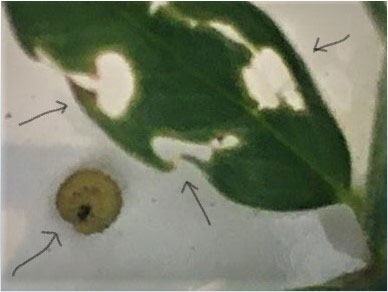The K-State Extension Entomology newsletter is back! The first issue of 2021 brings some old pests up for discussion. This newsletter is typically published each Friday during the growing season. Articles are targeted for agribusiness, applicators, consultants, extension personnel, and homeowners. When the topics cover an agronomic pest, the Extension Agronomy eUpdate will share those articles with the eUpdate audience.
Alfalfa Weevils
Alfalfa weevil larvae have been hatching throughout south central and north central Kansas for the last couple of weeks. First larvae/feeding reported from south central Kansas on March 15 and on March 21 from north central parts of the state. The easiest way to find new larvae is to note small, pinprick sized holes in leaves and/or brooming feeding damage on the tips of new terminals (Figure 1). Larval hatching and subsequent feeding will only increase as temperatures increase. It takes temperatures in the mid to low 20's(°F) for a couple hours to actually adversely affect young larvae (remember 2018- and last year, 2020, in mid-April). Also, please remember-- utilize whatever treatment threshold that has been successful for you in the past (hopefully-not just spray because your neighbor is--we use a 33-50% infestation level using the "stem count bucket "sampling method). In addition, it is really important to spray with an adequate amount of carrier, i. e. water, to achieve good coverage. After application, and the reentry interval (REI) for the product used, continue monitoring as eggs may continue to hatch for another few weeks, or until swathing. Also, always check the pre-harvest interval (PHI) for your product of choice.

Figure 1: Visual sings of leaf feeding and 1-day old larva. Photo by Cody Wyckoff, K-State Research and Extension.
Army Cutworms
Army cutworms are again relatively common this year, however, thus far, not nearly as destructive as last year (2020). This could be because infestations are much reduced compared to 2020 - or that growing conditions have been much better than last year for both alfalfa and wheat. However, birds (and/or skunks) feeding in alfalfa or wheat fields are still the easiest way to detect army cutworm larvae.
If you would like to receive Extension Entomology Newsletter, in addition to the eUpdate, you can visit the following website: http://entomology.k-state.edu/extension/newsletter/subscriptionpage.html
You can view past issues of the Extension Entomology Newsletter at: http://entomology.k-state.edu/extension/newsletter/index.html
Jeff Whitworth, Extension Entomologist
jwhitwor@ksu.edu